ikfoundation.org
The IK Foundation
Promoting Natural & Cultural History
Since 1988


 Crowdfunding Campaign
Crowdfunding Campaignkeep knowledge open, connected, and growing on this textile history resource...
TEXTILE INTERIOR IN 1873
– Observations of a 19th Century Folklore Researcher in Sweden
The artist and folklore researcher Nils Månsson Mandelgren (1813-99) made four journeys during the 1860s and 1870s to the most southerly province, Skåne in Sweden. This essay will focus on one single village, Everlöv, that he visited during his repeated yearly travels, together with a short introduction to his life and cooperation with early museums. Skilled female weavers in tapestry techniques, active over several generations, had put this particular village on the map long before his visit in the summer of 1873. However, observations from such a small geographical area became an essential part of his wide-stretching notes and drawings from journeys over several decades.
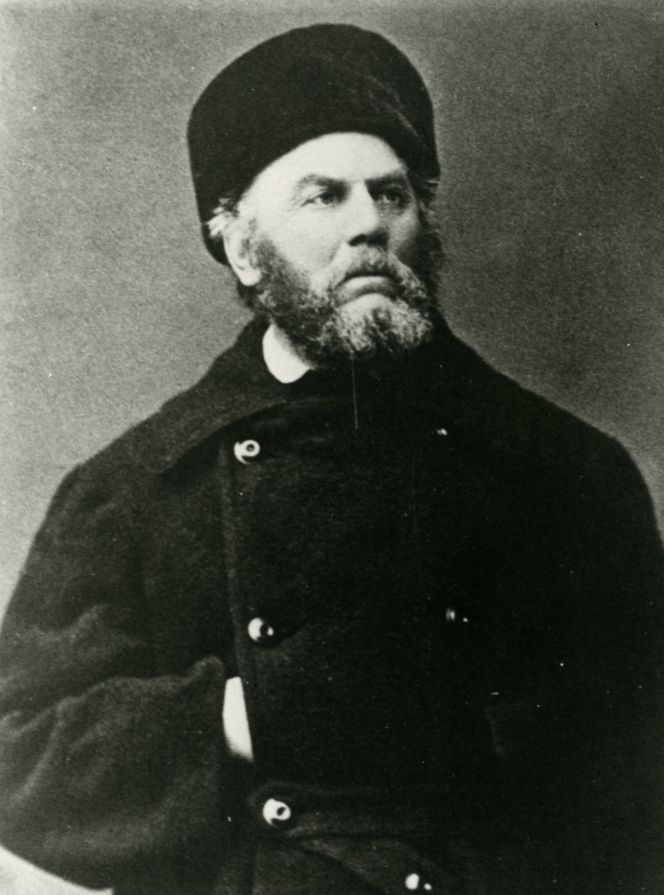 Nils Månsson Mandelgren photographed in winter clothing at an unknown date, probably during the 1860s or 1870s. That is to say around the same decades when he during a couple of years visited the most southerly province Skåne in summertime. Such local documentation was intertwined in a much larger phenomena of the time – nationally as well as internationally – the fascination to learn more about traditional handicraft and material culture. Early researchers like him often had an interest in the recent past (early 19th century), which gave them the opportunity to get firsthand accounts via interviews with the elderly or by viewing rich selections of textiles, still kept protected as family heirlooms. (Courtesy: Kalmar Museum, Sweden. KLMF.Okänd00551. DigitaltMuseum).
Nils Månsson Mandelgren photographed in winter clothing at an unknown date, probably during the 1860s or 1870s. That is to say around the same decades when he during a couple of years visited the most southerly province Skåne in summertime. Such local documentation was intertwined in a much larger phenomena of the time – nationally as well as internationally – the fascination to learn more about traditional handicraft and material culture. Early researchers like him often had an interest in the recent past (early 19th century), which gave them the opportunity to get firsthand accounts via interviews with the elderly or by viewing rich selections of textiles, still kept protected as family heirlooms. (Courtesy: Kalmar Museum, Sweden. KLMF.Okänd00551. DigitaltMuseum).His parents died early, so the young boy had to live with various relatives in the northeastern part of Skåne province. Drawing and painting were his interests, and already when he was 8 to 10 years old, he started to work with decorations of greeting cards, furniture and household utensils for the farmers’ needs in the local area. By chance, Mandelgren, as a 17-year-old, met Count Jacob Gustav de la Gardie (1768-1842), who understood the young farmer boy’s aptitude for art. He assisted the young man financially to receive a suitable art education, including several years of studies in both Stockholm and København (Copenhagen). After the completion of these studies, he was full of ideas: a stay abroad 1842-43, building and planning proposals in Stockholm, the founding of a Sunday art school, documentation of mural church paintings, an atlas of Sweden’s history of farming and his main mission in life as a travelling ethnographic researcher. His documentation work was introduced during the 1840s, but it was foremost between 1862 and 1891 as he made one systematical long journey every year in Sweden. The geographical area of his research stretched across the whole country, from Lapland in the north to Skåne in the south. During the winter months in Stockholm, he made fair copies of his fieldwork, drew conclusions and planned the following year’s journey.
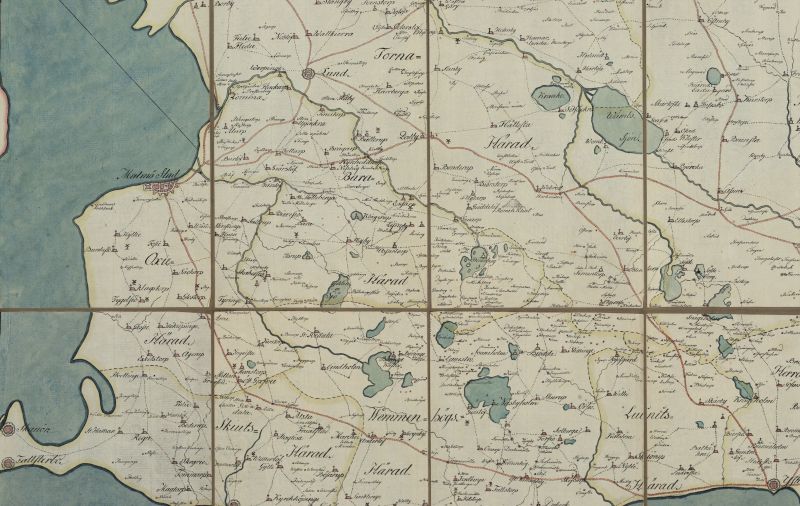 As initially mentioned, this essay will concentrate on Nils Månsson Mandelgren’s observations in one single village, which gives an idea of his working methods and long-term aims. Such a case study also enlightens his almost incomprehensible total efforts, which is evident via his extensive collection of almost 100.000 drawings, watercolours, photographs and written observations. Among many places in the summer of 1873, his journey took him to Everlöv village, Blentarp parish, Torna district in Skåne, the most southerly province of Sweden. A village, which was known for its skilled weavers since the previous century. The village was favourably situated halfway towards the university city of Lund, along the main land route from the coastal town Ystad where ships arrived from the Continent. | ‘Everlöf’ is marked out along the red coloured road between Ystad and and Lund on this map section of Skåne province, Sweden. (Courtesy: Uppsala University Library, Sweden. Alvin-record:98362. Part of map, copy dated 1812, from an original map, dated 1766. Public Domain).
As initially mentioned, this essay will concentrate on Nils Månsson Mandelgren’s observations in one single village, which gives an idea of his working methods and long-term aims. Such a case study also enlightens his almost incomprehensible total efforts, which is evident via his extensive collection of almost 100.000 drawings, watercolours, photographs and written observations. Among many places in the summer of 1873, his journey took him to Everlöv village, Blentarp parish, Torna district in Skåne, the most southerly province of Sweden. A village, which was known for its skilled weavers since the previous century. The village was favourably situated halfway towards the university city of Lund, along the main land route from the coastal town Ystad where ships arrived from the Continent. | ‘Everlöf’ is marked out along the red coloured road between Ystad and and Lund on this map section of Skåne province, Sweden. (Courtesy: Uppsala University Library, Sweden. Alvin-record:98362. Part of map, copy dated 1812, from an original map, dated 1766. Public Domain).When he visited Everlöv village and its inn during the summer of 1873, he met the innkeepers Lars Persson (1819-99) and Margaretha Persdotter (1818-96) who informed him about their family’s rich textile traditions. Furthermore, in the traces of Mandelgren’s documentation, the later established local Handicraft Organisation gave detailed accounts of “The weaving daughters of Everlöv” during the 1910s-20s and via the late textile historian Gertrud Ingers (1904-91) and her book published in 1975. Whereof six dovetailed tapestry woven bedcovers, produced in the late 18th century are the most complex and exquisite preserved textiles from this area. These bedcovers were made for the six daughters of Bolla Andersdotter (1734-91) and Pehr Olsson (1732-88), an endeavour probably organised by the mother, but woven by the daughters themselves for their respective dowries – all made between 1772 and 1782, at a time when the girls were about 16 to 17 years old. According to a later estimation, it must have taken at least 1085 hours to weave one such bedcover. See a detail from one of these very fine tapestries below.
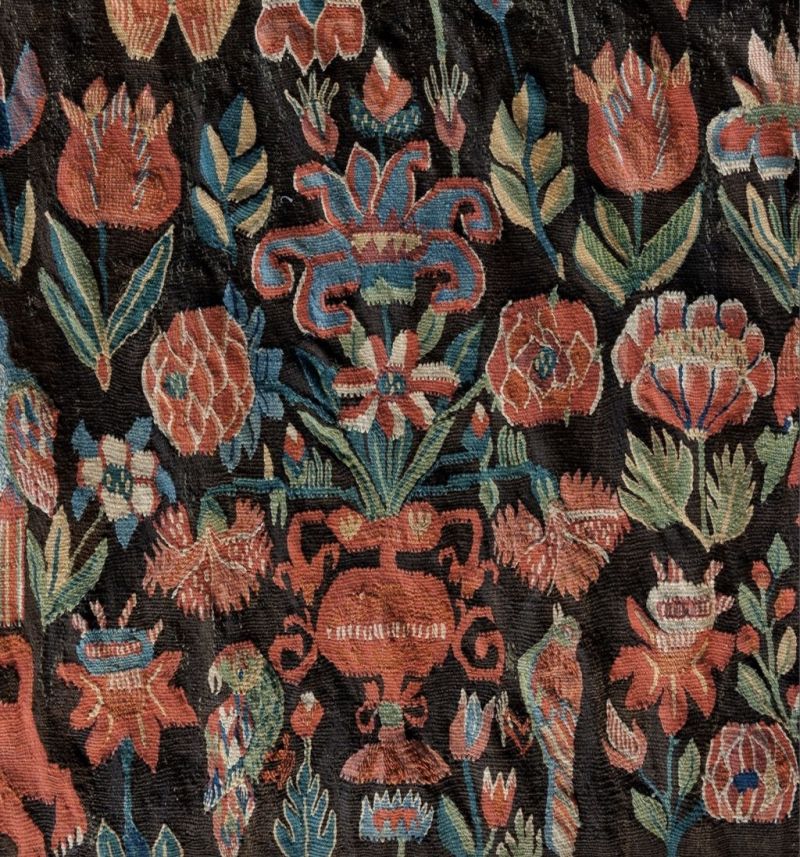 This is a detail from one of the six bedcovers, woven in the 1770s and marked “EPD-KPD”, which may indicate that it was woven by both sisters Elna (1756-1842) and Karna Persdotter (1758-1833). According to earlier research (Ingers, 1975 p. 28), this bedcover was part of Karna’s dowry prior to the wedding with the farmer Nils Mattson (1758-1833) in Everlöv. However, the bedcover was not mentioned by Nils Månsson Mandelgren in 1873, but it is believed to have stayed within the family until the 1880s when it was sold to Näsbyholm manor house situated in the same province. From this place it was included in the textile inventory made by the Handicraft Organisation (Malmöhusläns hemslöjd) in 1921 and illustrated a few years later in their major publication work of local textiles. In 1933 the bedcover was then sold at auction in Stockholm and donated to the Nordic Museum, which still today is the keeper of this beautiful and well-preserved bedcover. (Courtesy: The Nordic Museum, Sweden. NMA.0059502. DigitaltMuseum).
This is a detail from one of the six bedcovers, woven in the 1770s and marked “EPD-KPD”, which may indicate that it was woven by both sisters Elna (1756-1842) and Karna Persdotter (1758-1833). According to earlier research (Ingers, 1975 p. 28), this bedcover was part of Karna’s dowry prior to the wedding with the farmer Nils Mattson (1758-1833) in Everlöv. However, the bedcover was not mentioned by Nils Månsson Mandelgren in 1873, but it is believed to have stayed within the family until the 1880s when it was sold to Näsbyholm manor house situated in the same province. From this place it was included in the textile inventory made by the Handicraft Organisation (Malmöhusläns hemslöjd) in 1921 and illustrated a few years later in their major publication work of local textiles. In 1933 the bedcover was then sold at auction in Stockholm and donated to the Nordic Museum, which still today is the keeper of this beautiful and well-preserved bedcover. (Courtesy: The Nordic Museum, Sweden. NMA.0059502. DigitaltMuseum).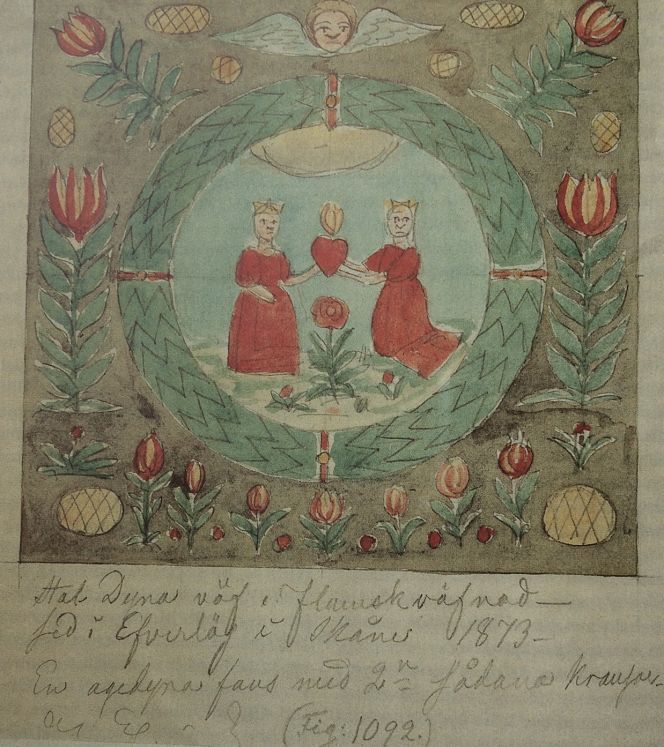 Nils Månsson Mandelgren made documentations of smaller sized dovetail tapestries in Everlöv. Particularly visible via this painting, when he had depicted the locally popular motif ‘The Annunciation’ within a wreath surrounded by various flowers etc. His attached note in translation reads: ‘A dovetail tapestry woven chair cushion, observed in Efverlöf in Skåne 1873. One travel cushion also existed, with two such wreaths’. (Courtesy: Folklivsarkivet… Mandelgren Collection, no. 1092).
Nils Månsson Mandelgren made documentations of smaller sized dovetail tapestries in Everlöv. Particularly visible via this painting, when he had depicted the locally popular motif ‘The Annunciation’ within a wreath surrounded by various flowers etc. His attached note in translation reads: ‘A dovetail tapestry woven chair cushion, observed in Efverlöf in Skåne 1873. One travel cushion also existed, with two such wreaths’. (Courtesy: Folklivsarkivet… Mandelgren Collection, no. 1092).![Nils Månsson Mandelgren’s illustration of a: ‘Vertical loom [haute-lisse] from Everlöv in Skåne 1874’ – arranged with its linen warp and the almost ready woven Annunciation motif with strong contrasting colours of woollen yarn. (Courtesy: Folklivsarkivet…Mandelgren Collection, no. 1052).](https://www.ikfoundation.org/uploads/image/5-loom-tapestry-weaving-664x891.jpg) Nils Månsson Mandelgren’s illustration of a: ‘Vertical loom [haute-lisse] from Everlöv in Skåne 1874’ – arranged with its linen warp and the almost ready woven Annunciation motif with strong contrasting colours of woollen yarn. (Courtesy: Folklivsarkivet…Mandelgren Collection, no. 1052).
Nils Månsson Mandelgren’s illustration of a: ‘Vertical loom [haute-lisse] from Everlöv in Skåne 1874’ – arranged with its linen warp and the almost ready woven Annunciation motif with strong contrasting colours of woollen yarn. (Courtesy: Folklivsarkivet…Mandelgren Collection, no. 1052).Additionally, this vertical loom used for weaving dovetail tapestries caught his interest from several perspectives. Firstly, the illustration above is one of two very similar watercolours (no. 1052 and 1091); noticeable is also the stand to the right of the loom, where the weaver, in an effective way as possible, could keep her various weft colours on spools at a handy distance. This watercolour is dated to the year after his visit to the village – 1874 – which does not imply that he visited Everlöv a second time. Instead, he had purchased the loom itself with an ongoing tapestry work on behalf of the Nordic Museum in Stockholm, and it was, thereafter, probably to be exhibited as a demonstration of this textile art form. The museum had been founded just two years previously by Artur Hazelius (1833-1901), who at this time was particularly eager to collect traditional craft from Skåne and other Swedish provinces. Judging by the outstanding details in this watercolour, one may also conclude that it was depicted by Mandelgren in Stockholm after the purchase of the loom – in contrast to the illustrated tapestry cushion further above, which, due to its coarser style seems to have been sketched and painted during the fieldwork in Everlöv.
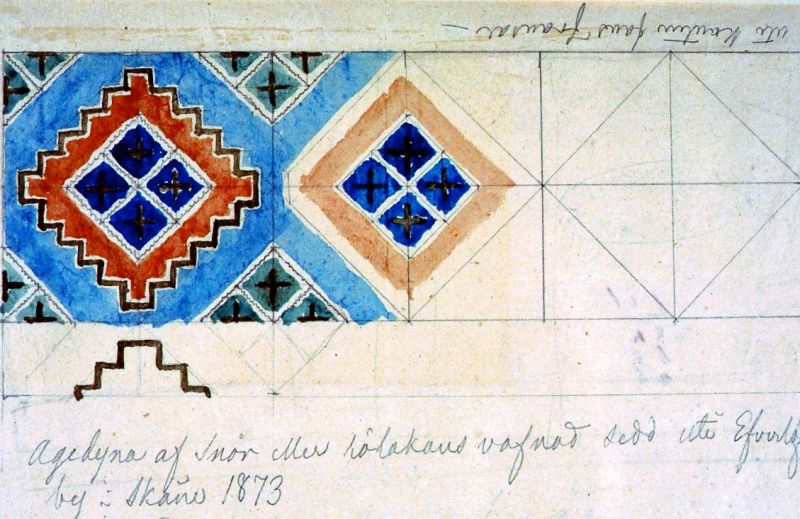 Double interlocked tapestries were woven more sparsely in Everlöv, but even so Mandelgren illustrated one such cushion in watercolour, which had a strict geometrical woven design. He noted; ‘Travel cushion of double interlocked tapestry or “rölakan” studied in Efverlöf village, Skåne 1873’. This design was somewhat more popular locally in the so-called “tvistsöm” embroidery, stitched with woollen threads on a coarse linen canvas. (Collection: Folklivsarkivet…Mandelgren Collection, no. 1093). Photo: The IK Foundation.
Double interlocked tapestries were woven more sparsely in Everlöv, but even so Mandelgren illustrated one such cushion in watercolour, which had a strict geometrical woven design. He noted; ‘Travel cushion of double interlocked tapestry or “rölakan” studied in Efverlöf village, Skåne 1873’. This design was somewhat more popular locally in the so-called “tvistsöm” embroidery, stitched with woollen threads on a coarse linen canvas. (Collection: Folklivsarkivet…Mandelgren Collection, no. 1093). Photo: The IK Foundation. He made several observations of embroideries too, including a woollen “tvistsöm” embroidery marked ‘1855 E P D stitched on canvas’ (no. 1635). Another travel cushion of the same embroidery technique (no. 1090a) was mentioned to have a red knot-style design on a green ground with the marking ‘ANO 1803 D 8 A GTI HID EKD IHS’, whilst the back was lined with a fabric of weft patterned tabby type opphämta. The extensive marking most probably indicates that this particular embroidery was part of the young woman’s dowry and, when used the very first time, in the form of a wedding travel cushion towards the church on 8th August 1803. This embroidery as well as two bedcovers woven in the opphämta technique (no. 1090b), both were carefully depicted and coloured by Mandelgren. It seems like these intricately woven star-designed opphämta bedcovers, in particular, caught his interest, as he made one further such sketch and noted: ‘Star bedcover seen in Efverlöf village in Skåne 1873’. Other illustrations made from Everlöv village included:
- Bedcover, woven in monk’s belt with a star design in contrasting colours (no. 1081).
- Pencil drawings of a vertical loom used for dovetail tapestry (no. 1052).
- Two linen pillowcases, embroidered with various whitework stitching (no. 1624a-b).
A few other primary sources – in the form of his notes and correspondence – reveal some further details of textiles in this village. For instance, he described how the long-lasting handicraft traditions had become unfashionable at the time of his visit in 1873:
- ‘So now it is only the elderly women crofters who had knowledge about this art… Berta in Blentarp and Ingar Halja and Nils Per’s wife in Himelstorp. There are also dovetail tapestry weaves, which were woven by the innkeeper’s wife [Berta Olsdotter born in 1802] in Everlöv’.
Additionally, Mandelgren had contact with the same Berta Olsdotter via a woman named Eva Paulsson in correspondence dated 9th June and 11th July in 1874. His wish was to order some sort of art woven tapestry, probably in the dovetail technique, due to the cost and substantial time it was estimated to take to produce. Among other matters, Paulsson mentioned in her letter:
- ‘I have paid the 20 Riksdaler, which the old woman has asked for. I have visited her several times to try to hurry the work… now she has woven a full aln [ell, c. 60 cm], very skilfully and beautifully made.’
In other words, the traditional knowledge of dovetail tapestry weaving was still in 1873, something some elderly women mastered in this village in southernmost Sweden. From the 1870s and during the coming 50 years, Mandelgren, other enthusiasts for traditional craft, early museums, handicraft organisations and others managed to give this multitude of textile knowledge “new life”. First and foremost, via in-depth documentation, exhibitions, publications, weaving schools and preservations of a wide array of these domestic interior furnishing objects. It is worth noticing that Everlöv had been one of hundreds of village communities in Skåne province – where such decorative weaving and embroidery traditions had been learned from mother to daughter over the generations for at least 150 years.
Quotes from N.M. Mandelgren’s images, notes and correspondence have been translated from Swedish into English by the author of this essay.
Sources:
- Folklivsarkivet i Lund (Folklore Archive in Lund) Sweden. [Nils Månsson Mandelgren’s Collections].
- Hansen, Viveka, Textila Kuber och Blixtar – Rölakanets Konst och Kulturhistoria, Christinehof 1992.
- Hansen, Viveka, ‘Mandelgrens intresse för textilier i Skåne’, Ale no. 2, pp. 13-23, 1998.
- Hansen, Viveka, The Textilis Essays, ‘Unique 19th Century observations of Textiles and Clothing’ (No: XVII. April 22, 2014).
- Ingers, Gertrud, Gästgivaredöttrarna i Everlöv, Stockholm 1975.
- Jacobsson, Bengt, Nils Månsson Mandelgren. En resande konstnär i 1800-talets Sverige, Lund 1983.
- Lund University Library, Sweden (Letters to and from Nils Månsson Mandelgren).
- Malmöhusläns hemslöjdsförening, Gammal Allmogeslöjd, Malmö 1924.
- Skånes Hembygdsförbund, Mandelgren i Skåne, Årsbok 1992.
Essays
The iTEXTILIS is a division of The IK Workshop Society – a global and unique forum for all those interested in Natural & Cultural History.
Open Access Essays by Textile Historian Viveka Hansen
Textile historian Viveka Hansen offers a collection of open-access essays, published under Creative Commons licenses and freely available to all. These essays weave together her latest research, previously published monographs, and earlier projects dating back to the late 1980s. Some essays include rare archival material — originally published in other languages — now translated into English for the first time. These texts reveal little-known aspects of textile history, previously accessible mainly to audiences in Northern Europe. Hansen’s work spans a rich range of topics: the global textile trade, material culture, cloth manufacturing, fashion history, natural dyeing techniques, and the fascinating world of early travelling naturalists — notably the “Linnaean network” — all examined through a global historical lens.
Help secure the future of open access at iTEXTILIS essays! Your donation will keep knowledge open, connected, and growing on this textile history resource.
been copied to your clipboard




– a truly European organisation since 1988
Legal issues | Forget me | and much more...
You are welcome to use the information and knowledge from
The IK Workshop Society, as long as you follow a few simple rules.
LEARN MORE & I AGREE







